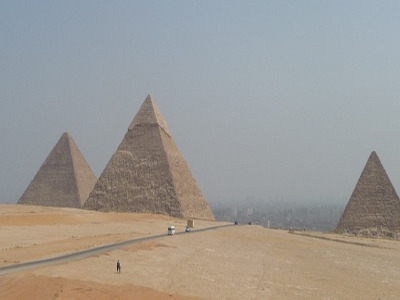The seven wonders of the ancient world are still considered some of the greatest achievements of architecture. While the whole world is in a state of constant change and is always progressing, these constructions are proof of past times. Their construction required a lot of craftsmanship and an eye for aesthetics. The various buildings are from long ago, and each has its own history. Unfortunately, only one of the seven wonders is still preserved, as the rest have been severely damaged or completely destroyed by wars or natural disasters such as earthquakes.
This was one of the reasons why in 2007, new wonders of the world (Chichén Itzá, the Great Wall of China, Christ the Redeemer Statue, the Colosseum in Rome, Macchu Picchu, the city of Petra, and the Taj Mahal) were appointed. The new list is very controversial, as the whole nature of the election process has called for discussion.

- The Great Pyramids of Giza
The Great Pyramids of Giza were built for three pharaohs. Their imposing exterior testifies to great worship for these pharaohs. The largest pyramid (height: 147m) was built for Khufu, the middle one (height: 143m) for Khafre, and the smallest one (height: 66m) for Mykerinus. In the pyramids are shown shafts and tunnels, but no treasures or similar. Also, the human remains of the pharaoh kings were never found. The pyramids, which are made of solid rock from the outside, were built by Egyptians who transported the stones with sledges, ropes, and ramps. Herodotus, a Greek historian, recorded that the construction took about 20 years and involved about 100,000 workers. Recent findings show, however, that perhaps only 20,000 workers were needed. The Great Pyramids of Giza are the only wonder of the world that is still intact. - The hanging gardens of Babylon
King Nebuchadnezzar II gave the instructions to build the hanging gardens in Babylon (Iraq). He let them be built for his wife, Queen Amytis of Media, as a present around the year 600 BC. Around the 1st century BC, the gardens of Babylon were destroyed due to an earthquake. This is why some people doubt that they ever existed in the first place. Archaeological excavations in Iraq revealed very thick stone walls, but they were found in a different place than the one that was described in the reports of the historians. - Temple of Artemis
This temple, which was dedicated to the Greek goddess of hunting, was built in the 6th century BCE during the reign of King Croesus in today’s Turkey. Its completion took 120 years. Excavations revealed a column that is the only remnant of the temple. Now, one can see it in the British Museum. After the temple was destroyed by a fire that was set intentionally by Herostratus, it was rebuilt and was even more glamorous and higher. In the 3rd century CE, the temple was eventually destroyed by an attack by the goths. - Statue of Zeus at Olympia
The enormous sitting statue known as the Statue of Zeus at Olympia was created at the Temple of Zeus in Greece about 435 BC by the Greek sculptor Phidias. It stood at a height of around 12.4 meters. In Greek mythology, Zeus was the god of the sky and thunder, reigning as the head of the Mount Olympus gods. The statue was a timber structure supporting a chryselephantine sculpture made of ivory plates and gold panels. Zeus was seated on a painted cedarwood throne adorned with valuable stones, ebony, ivory, and gold. It was lost and destroyed in the fifth century AD. - Mausoleum of Mausolus
The Mausoleum of Mausolus, also called the Mausoleum of Halicarnassus, was located in the southwest of Asia Minor, in Halicarnassus. In 353 BCE, it was built, and its completion took two years. Furthermore, the widow and sister of Mausolus (Mausolus was the ruler of Caria), Artemisia II, was the one who built it after the design of the Greek architects, called Pythius (his existence is not confirmed though) and Satyros. The Mausoleum of Mausolus was square-shaped and had a circumference of about 125 meters. With a total of 36 columns and a pyramid with 24 steps, it was quite impressive.
Unfortunately, between the 11th and 15th centuries CE, the mausoleum was destroyed due to an earthquake, but some fragments can still be visited at the British Museum. - Colossus of Rhodes
In order to worship and honor the Greek god of the sun, Helios, a gigantic statue was built that is known under the name Colossus of Rhodes. The statue, which probably stood in the harbor of Rhodes, was 32 meters high, made out of bronze and iron, and showed Helios, who was only covered with a cloak. Moreover, it was built from 294 to 282 BCE and destroyed around 225 BCE by an earthquake. - Lighthouse of Alexandria
The Lighthouse of Alexandria, also known as the Pharos of Alexandria, is one of the biggest architectural and technological achievements of its time. The architect was Sostratus of Cnidus, and he designed it for Ptolemy I Soter. Its construction was finished around 280 BCE. I was situated on Pharos Island, in Alexandria’s harbor. The only construction that surpassed the lighthouse in height was another world wonder, the Pyramids of Giza. An earthquake destroyed the Lighthouse of Alexandria in the 1300s.
https://de.wikipedia.org/wiki/Weltwunder#Geschichte
https://education.nationalgeographic.org/resource/seven-wonders-ancient-world/
https://www.britannica.com/topic/Pyramids-of-Giza
https://www.dkfindout.com/us/history/seven-wonders-world/hanging-gardens-babylon/#:~:text=The%20Hanging%20Gardens%20of%20Babylon%20were%20supposed%20to%20have%20been,Gardens%20reminded%20her%20of%20home.
https://kids.kiddle.co/Hanging_Gardens_of_Babylon
https://www.througheternity.com/en/blog/things-to-do/The-History-and-Legends-of-the-Temple-of-Artemis-of-Ephesus-One-of-the-Seven-Wonders-of-the-Ancient-World.html#
https://kids.kiddle.co/Statue_of_Zeus_at_Olympia
https://www.britannica.com/topic/Mausoleum-of-Halicarnassus
https://www.britannica.com/topic/Colossus-of-Rhodes
https://www.britannica.com/topic/lighthouse-of-Alexandria
